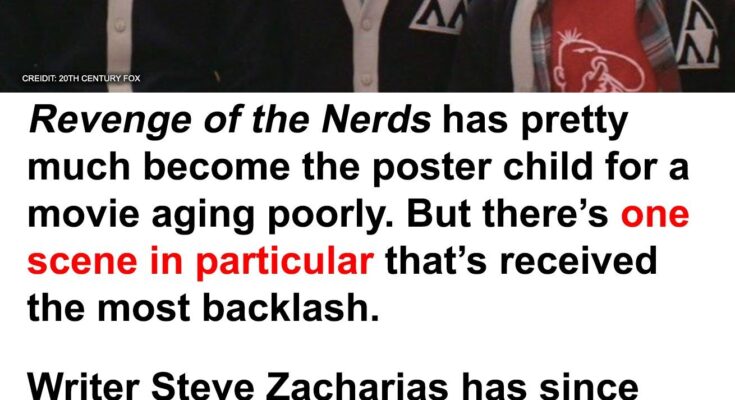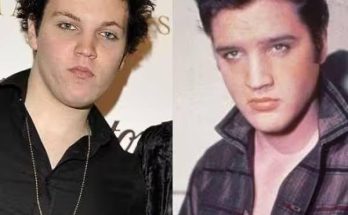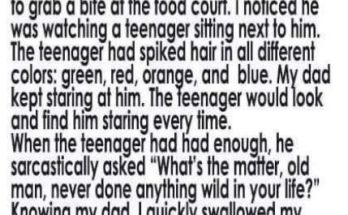Almost everyone has at least one cult film they adore. Indeed, there is something more than a little liberating about loving an object that has been rejected by either critics or by audiences in a particular time and place.
Some cult classics, for whatever reason, manage to stand the test of time, and they are as enjoyable in the present as they have been throughout the years. Others, however, really show their age – often because they indulge in racist, sexist, or homophobic humor or plots that punch down on those who have been marginalized in society. The following films are much more “of their time” than they seemed at the time, and don’t align with contemporary values. Don’t believe us? Read on, and decide which films are more deserving of cringeworthy than cult status.
Revenge of the Nerds

Photo: 20th Century Fox
The raunchy frat house comedy was one of the staples of 1980s cinema, and one of the best examples of the genre is Revenge of the Nerds, which focuses on the titular nerds as they do battle with the popular fraternities and sororities on campus. It’s a film filled with the usual sex jokes and juvenile humor. It really does push the envelope in what it chooses to depict, and it is especially queasy when it comes to issues of consent.
One plot line sees the nerds install cameras to spy on naked sorority women and then sell the resulting images of them without their knowledge. In another, even more controversial scene, one of the film’s protagonists deceives a member of a sorority to sleep with him by wearing a Darth Vader mask he stole from her boyfriend, who was wearing it earlier that night. Though played for laughs, these are moments that are genuinely horrifying in the MeToo era (not to mention crimes!). They are, moreover, highly symptomatic of a 1980s culture that often privileged the male point of view both in terms of plot and in terms of what was actually shown in the film itself.
Writer Steve Zacharias and director Jeff Kanew have since responded to backlash over the masked scene, with Zacharias telling GQ, “I regret that.” Kanew said that while it was seen differently at the time, “In a way, it’s not excusable… If it were my daughter, I probably wouldn’t like it.”
The Gods Must Be Crazy

Photo: Ster-Kinekor
The Gods Must Be Crazy, like so many films from the 1980s, is very much a product of its time. Focusing on Xi, a member of the San tribe; Dr. Andrew Steyn, a white scientist; and Kate Thompson, his assistant; the film follows them as their lives and fates become increasingly intertwined after Xi and his tribe discover a Coke bottle on their lands.
Even at the time, the film came under considerable fire for the extent to which it seems to position the members of the Xi clan as intellectually inferior to their white counterparts. Just as pernicious is the vision the film offers of South Africa, which during the film’s production was still ruled by apartheid. To see this glossed over was distressing when the film was released in the 1980s; it reads as well-nigh unconscionable in 2023.
Barbarella

Photo: Paramount Pictures
Though today Jane Fonda is probably best known for starring in Grace and Frankie, in the 1960s she appeared in a variety of comedies and other films, one of the most notable of which was Barbarella. Fonda plays the title character, a space adventurer. It’s one of the actress’s most noted performances from the decade, and her natural charisma as a performer more than makes up for whatever is lacking in the screenplay.
The film’s gender politics certainly leave much to be desired, certainly from the standpoint of the 21st century. Among other things, Barbarella is highly sexualized throughout the film, and there is even a moment when she is put in a machine designed to provide a deadly form of pleasure. For some this will no doubt read as the excesses of late 1960s science fiction and pulp, but it’s also more than a little creepy.

Chasing Amy is also ranked #33 of 95 on The 100+ Best Movies Of 1997
Photo: Miramax Films
Writer-director Kevin Smith made a movie about a lesbian protagonist at a time when LGBTQ+ characters rarely took center stage in motion pictures. Audiences and critics loved Chasing Amy, but it hasn’t translated well to modern sensibilities, mainly because the character of Alyssa Jones (Joey Lauren Adams) is a straight man’s fantasy.
Alyssa is buxom, blond, and beautiful, and has no problem sucking face in public with her equally beautiful girlfriend. But she’s also got a colorful sexual history for which she is brutally shamed. And her lesbianism appears to be the variable kind, as she’s soon shacking up with Holden McNeil (Ben Affleck).
All sexuality is a spectrum, but it’s highly doubtful this is the kind of nuance Smith was going for. If he was, he didn’t explore it in any depth, considering how the word “bisexual” does not appear in the script. It’s more likely meant to be a plot device that (intentional or not) spreads the myth that lesbians “just haven’t met the right man.”
Eight Crazy Nights

Photo: Sony Pictures
Some cult classics become what they are because of the way they push the envelope of good taste, often to an extraordinary degree. Even by such standards, however, Eight Crazy Nights is truly extraordinary, and though it is refreshing to see an animated holiday special taking place at Hanukkah, everything else about the film was juvenile to begin with and has only gotten worse in the 20 years since its release.
In addition to some outright racist moments, there is also a preponderance of scatalogical humor which, even for the early 2000s doesn’t quite land and seems even more grotesque from a present standpoint. There’s even a scene where a character gets pushed into a Port-a-Potty, which is then pushed down a hill. It’s obviously meant to tap into the gross-out comedy stylings so common in the 2000s, but even with those standards the film doesn’t always succeed nearly as much as it clearly wants to.
Waiting…

Photo: Lionsgate
The early 2000s was a bit of a golden age for indie comedies, many of which take a particular delight in pushing the boundaries of good taste. Waiting…, from 2005, is about what one would expect from a film like this one, focusing as it does on the disenchanted, and raunchy, wait staff at a franchise restaurant. It does, however, feature some notable cast members, including Ryan Reynolds, Justin Long, Anna Faris, and Luis Guzmán.
Even for a film of this type, however, there are some very questionable, and sometimes downright gross, moments. One of the games the wait staff like to play is to expose their genitalia to their coworkers who, of course, don’t know this is about to happen. It is called, of course, “The Penis Game,” and another instruction of the game is to then hurl homophobic slurs. Even more gross is the ongoing storyline about one of the employees who happens to be underage. This was pushing the boundaries when the film was released; it feels even more gross and morally reprehensible now. All of this probably contributed to Rotten Tomatoes’ overall consensus of the film as “a gross-out comedy that is more gross than comic.”
Fast Times at Ridgemont High

Photo: Universal Pictures
Hollywood has long had a fascination with the lives of high schoolers, and one of the paradigmatic examples of the teen drama is Fast Times at Ridgemont High. With its sprawling cast of characters, it depicts a fascinating cross-section of high school life. It’s an undeniably funny film, but there are some things that seem more than a little cringe from the standpoint of 2023.
In addition to the flippant homophobia (something which was all too common in the real world of the time), some of the film’s assumed ideas about the nature of consent are dubious. The sex scenes are still a bit difficult to watch, particularly since it remains unclear the extent to which the women in particular actually want to be having sex with their male partners.
While the film deserves credit for its willingness to explore sexuality in a more mature way, these scenes are still troubling.
Dazed and Confused

Dazed and Confused is also ranked #7 of 185 on Movies With The Best Soundtracks
Photo: Gramercy Pictures
In addition to being one of the best-known coming-of-age comedies of the 1990s, Dazed and Confused is also famous for its cast, most of whom went on to gain significant fame despite the film’s lackluster performance at the box office. However, Matthew McConaughey’s character, David Wooderson, is more than a little creepy, even by the standards of the early 1990s.
His transparent chasing of younger women is one of his most noteworthy character traits, and though McConaughey certainly leans into the sleaziness of his character, it’s nevertheless unclear to what extent the film wants the viewer to see this behavior as worthy of condemnation rather than humorous discomfort.
Watching it from 2023 can be more than a little cringe-inducing, particularly since the film doesn’t seem particularly interested in giving the viewer insight into what these young women feel like as they are being ogled and objectified by a man who really shouldn’t be lurking around them.
The Monster Squad

Photo: TriStar Pictures
It’s easy to see why The Monster Squad would become a beloved cult classic from the 1980s. Its story about a group of kids who have to stop the combined might of the various classic monsters from Universal Studios – including Dracula, the Wolfman, and the Creature from the Black Lagoon – is very much a product of its time, for better and for worse.
On the one end of the spectrum there is the obligatory obese character who is picked on by both other kids and by his friends; he is even derisively referred to as simply “Fat Kid.” More perplexing are the sexual innuendos and overtones, which feel very out of place – and more than a little icky – in a film primarily geared toward kids. Of particular note is the older kid who wants to join the younger kids just so he can spy on a young woman while she undresses. As happened so often in the 1980s, even kids’ movies were shot very much from and for the male gaze.
Heavy Metal

Photo: Columbia Pictures
When it was released, the film Heavy Metal was more than a little revolutionary. Composed of a series of animated shorts loosely connected by the presence of a sinister rock known as the Loc-Nar, it owes a great deal to the pulp magazine aesthetic. Indeed, many of the vignettes contained within the story are based on stories from the magazine of the same name (though a few are also original for the film).
As such, it definitely pushes the envelope, and there are significant depictions of blood and scantily-clad women. Indeed, almost all of the major female characters are rendered into little more than sex objects – a convention in a great deal of pulp – which makes it feel even more dated than many of the other films from the 1970s and early 1980s.
Given the strides that women have made in the world of speculative fiction, Heavy Metal feels like a look backward, even though it is very much in sync with the male-dominated 1980s.
Adventures in Babysitting

Photo: Buena Vista Pictures
The 1980s was a particularly rich decade for cult films, and Adventures in Babysitting is the type of film whose title says it all. In fact, the film centers around Chris Parker (played by Elizabeth Shue) as her babysitting gig goes rapidly awry. It’s a very funny film, and it has many of the traits that made Chris Columbus such a popular director in the 1990s.
However, there are at least two things that have not aged particularly well. In one distressing scene, young Daryl looks down the shirt of the sleeping Brenda. While played for laughs, it’s yet another indication of the way so much 1980s cinema was governed by an implicitly male gaze. Just as perplexing is its stereotypical use of its Black characters, almost all of whom are meant to represent the menace posed by the inner city.



